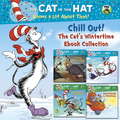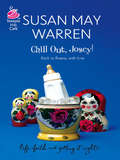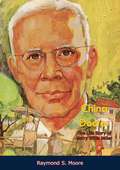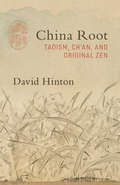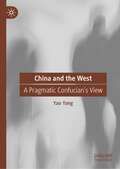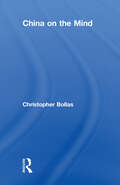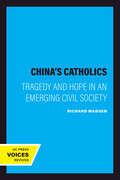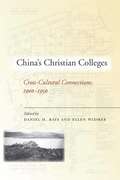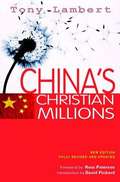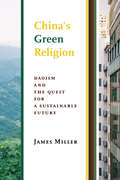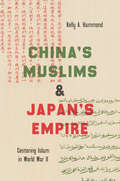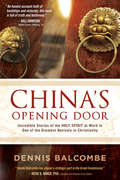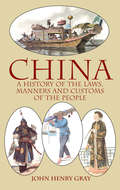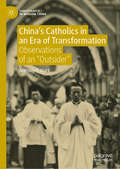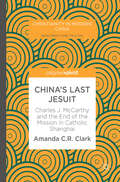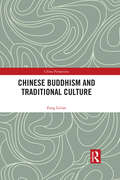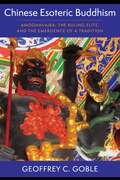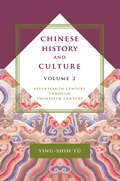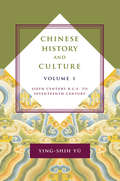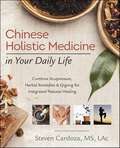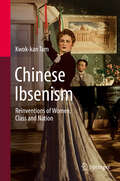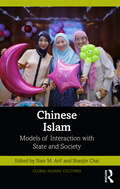- Table View
- List View
Chill Out! The Cat's Wintertime Ebook Collection: A Reindeer's First Christmas; New Friends for Christmas; A Long Winter's Nap; Flight of the Penguin (Pictureback(R))
by Joe Mathieu Aristides Ruiz Tish RabeCurl up and chill out with this winter-themed omnibus including four ebooks based on the hit PBS Kids' TV show The Cat in the Hat Knows a Lot About That! With two based on the PBS Kids' holiday special The Cat in the Hat Knows a Lot About Christmas! (A Reindeer's First Christmas and New Friends for Christmas), and two based on the TV show (A Long Winter's Nap--a story about hibernation), and Flight of the Penguin (a story about--what else?--penguins), this is a perfect holiday gift that can be enjoyed long beyond the holidays!
Chill Out, Josey!
by Susan May WarrenJosey Anderson will be the perfect wife. She and Chase did have the perfect wedding-if you don't count the matron of honor going into labor. Now all she has to do is find a cute Cape-style house, report for the Gull Lake, Minnesota, paper, bake cookies and learn to sew-is that so difficult?But when Chase lands a new job-in Moscow-Josey's dreams disintegrate. After all, she's been there, done that as a missionary, and a city without year-round hot water, decent takeout or...maternity clothes-that's not perfection! But what's the perfect wife to do?
China Cry: The Nora Lam Story
by Nora Lam Richard H. SchneiderChina Cry is the true story of the love, courage, and struggles of one woman -- Nora Lam -- whose Christian faith leads her to make the ultimate choice between life and death. Set in China some thirty years before the bloody Tiananmen Square massacre, this sweeping drama portrays the harsh reality of the repressive Communist regime and Nora Lam's indomitable will to survive.
China Doctor: The Life Story of Harry Willis Miller
by Raymond S. MooreHere is the full story of one man’s adventures as he seeks out the poor and sick in China as a medical missionary, and who was still busily at work in the Far East in his 80’s. In that time he built 15 hospitals and clinics, improvised and improved operation techniques, becoming one of the most widely practiced surgeons in the world, made new discoveries in preventive medicine, invented and developed soybean milk, which is responsible today for saving thousands of lives in undernourished areas of the world, was consulting physician to three U.S. Presidents and personal physician to senators and ambassadors.All this and much more is told us by Raymond S. Moore, vice-president of the College of Medical Evangelists in Loma Linda, California. It is a thrilling story of what happens when a man gives himself and his talents to the service of God. This book deserves a prominent place in the annals of those modern missionaries whose deeds prove that there is still romance and thrill in lives that are God-seeking rather than self-serving.“It is not too much to say that the whole thrilling history of missionary enterprise during the past 100 years has produced few more towering figures than Dr. Harry W. Miller.“He is not only in the inspiring tradition of such all-time ‘greats’ as Livingstone, Judson and Paton, whose dedicated skills indelibly marked the maps with Christian humanitarianism throughout the world’s far places, he is also a restless creator of new traditions, a modern-day pioneer whose imaginative use of medicine has touched millions with the magic of new hope and health.“We are indebted to Raymond S. Moore for this moving and revealing account of Dr. Miller’s unique and infinitely varied life and work.”—Clarence Hall, Senior Editor of Reader’s Digest and author of ADVENTURERS FOR GOD
China Journal 1889-1900: An American Missionary Family During the Boxer Rebellion
by Eva J. PriceBiography of an American family in China during the Boxer Rebellion, based on letters and diaries from the author.
China Root: Taoism, Ch’an, and Original Zen
by David HintonA beautifully compelling and liberating guide to the original nature of Zen in ancient China by renowned author and translator David Hinton.Buddhism migrated from India to China in the first century C.E., and Ch'an (Japanese: Zen) is generally seen as China's most distinctive and enduring form of Buddhism. In China Root, however, David Hinton shows how Ch'an was in fact a Buddhist-influenced extension of Taoism, China's native system of spiritual philosophy. Unlike Indian Buddhism's abstract sensibility, Ch'an was grounded in an earthy and empirically-based vision. Exploring this vision, Hinton describes Ch'an as a kind of anti-Buddhism. A radical and wild practice aspiring to a deeply ecological liberation: the integration of individual consciousness with landscape and with a Cosmos seen as harmonious and alive.In China Root, Hinton describes this original form of Zen with his trademark clarity and elegance, each chapter exploring in enlightening ways a core Ch'an concept--such as meditation, mind, Buddha, awakening--as it was originally understood and practiced in ancient China. Finally, by examining a range of standard translations in the Appendix, Hinton reveals how this original understanding and practice of Ch'an/Zen is almost entirely missing in contemporary American Zen, because it was lost in Ch'an's migration from China through Japan and on to the West.Whether you practice Zen or not, taking this journey on the wings of Hinton's remarkable insight and powerful writing will transform how you understand yourself and the world.
China and the West: A Pragmatic Confucian’s View
by Yao YangThis is an authored volume of Dr. Yao's “big-picture” writings on China and the West, translated by David Ownby. Those writings are selected from his writings as a public intellectual, reflecting his thought on China’s path of modernization and the effort to rebuild a political philosophy based on Confucianism, his interpretation of China’s political system and his prescriptions to improve it. A moderate, yet influential scholar, Yao's work has had great influence on Chinese social and economic policymakers; his project of renewing China's traditional value system is an important position, as Chinese reforms begin to focus on equity and inclusion. In an engaging, at times personal, and thoughtful volume, Dr. Yao's vision of a gentler Chinese society will interest Sinologists, political scientists, and journalists.
China on the Mind
by Christopher BollasSeveral thousand years ago Indo-European culture diverged into two ways of thinking; one went West, the other East. Tracing their differences, Christopher Bollas examines how these mentalities are now converging once again, notably in the practice of psychoanalysis. Creating a freely associated comparison between western psychoanalysts and eastern philosophers, Bollas demonstrates how the Eastern use of poetry evolved as a collective way to house the individual self. On one hand he links this tradition to the psychoanalytic praxes of Winnicott and Khan, which he relates to Daoism in their privileging of solitude and non verbal forms of communicating. On the other, Bollas examines how Jung, Bion and Rosenfeld, assimilate the Confucian ethic that sees the individual and group mind as a collective, while Freudian psychoanalysis he argues has provided an unconscious meeting place of both viewpoints. Bollas’s intriguing book will be of interest to psychotherapists, psychoanalysts, Orientalists, and those concerned with cultural studies.
China's Catholics: Tragedy and Hope in an Emerging Civil Society (Comparative Studies in Religion and Society #12)
by Richard MadsenAfter suffering isolation and persecution during the Maoist era, the Catholic Church in China has reemerged with astonishing vitality in recent years. Richard Madsen focuses on this revival and relates it to the larger issue of the changing structure of Chinese society, particularly to its implications for the development of a "civil society."Madsen knows China well and has spent extensive time there interviewing Chinese Catholics both young and old, the "true believers" and the less devout. Their stories reveal the tensions that have arisen even as political control over everyday life in China has loosened. Of particular interest are the rural-urban split in the church, the question of church authority, and the divisions between public and underground practices of church followers.All kinds of religious groups have revived and flourished in the post-Mao era. Protestants, Buddhists, Daoists, practitioners of folk religions, even intellectuals seeking more secularized answers to "ultimate" concerns are engaged in spiritual quests. Madsen is interested in determining if such quests contain the resources for constructing a more humane political order in China. Will religion contribute to or impede economic modernization? What role will the church play in the pluralization of society? The questions he raises in China's Catholics are important not only for China's political future but for all countries in transition from political totalitarianism.
China's Christian Colleges
by Daniel Bays WidmerMulticultural interactions between Americans and Chinese take center stage as social scientists, historians, and other researchers trace the history of 13 Protestant and three Catholic colleges over the half century before they merged into state institutions. Among their topics are American geometries and the architecture of the campuses in China, liberal arts education in English and campus culture at St. John's University, Anglo-American law at Soochow University, the American postwar plan for China's Christian colleges 1943-46, and Umeko Tsuda's Bryn Mawr network and the founding of Tsuda College. The 13 papers are from a September 2003 conference at Wesleyan University. Annotation c2010 Book News, Inc. , Portland, OR (booknews. com)
China's Christian Millions (new edition)
by Tony LambertA look at how God is working in the country of China.
China's Green Religion: Daoism and the Quest for a Sustainable Future
by James MillerHow can Daoism, China's indigenous religion, give us the aesthetic, ethical, political, and spiritual tools to address the root causes of our ecological crisis and construct a sustainable future? In China's Green Religion, James Miller shows how Daoism orients individuals toward a holistic understanding of religion and nature. Explicitly connecting human flourishing to the thriving of nature, Daoism fosters a "green" subjectivity and agency that transforms what it means to live a flourishing life on earth.Through a groundbreaking reconstruction of Daoist philosophy and religion, Miller argues for four key, green insights: a vision of nature as a subjective power that informs human life; an anthropological idea of the porous body based on a sense of qi flowing through landscapes and human beings; a tradition of knowing founded on the experience of transformative power in specific landscapes and topographies; and an aesthetic and moral sensibility based on an affective sensitivity to how the world pervades the body and the body pervades the world. Environmentalists struggle to raise consciousness for their cause, Miller argues, because their activism relies on a quasi-Christian concept of "saving the earth." Instead, environmentalists should integrate nature and culture more seamlessly, cultivating through a contemporary intellectual vocabulary a compelling vision of how the earth materially and spiritually supports human flourishing.
China's Muslims and Japan's Empire: Centering Islam in World War II (Islamic Civilization and Muslim Networks)
by Kelly A. HammondIn this transnational history of World War II, Kelly A. Hammond places Sino-Muslims at the center of imperial Japan's challenges to Chinese nation-building efforts. Revealing the little-known story of Japan's interest in Islam during its occupation of North China, Hammond shows how imperial Japanese aimed to defeat the Chinese Nationalists in winning the hearts and minds of Sino-Muslims, a vital minority population. Offering programs that presented themselves as protectors of Islam, the Japanese aimed to provide Muslims with a viable alternative—and, at the same time, to create new Muslim consumer markets that would, the Japanese hoped, act to subvert the existing global capitalist world order and destabilize the Soviets. This history can be told only by reinstating agency to Muslims in China who became active participants in the brokering and political jockeying between the Chinese Nationalists and the Japanese Empire. Hammond argues that the competition for their loyalty was central to the creation of the ethnoreligious identity of Muslims living on the Chinese mainland. Their wartime experience ultimately helped shape the formation of Sino-Muslims' religious identities within global Islamic networks, as well as their incorporation into the Chinese state, where the conditions of that incorporation remain unstable and contested to this day.
China's Opening Door: Incredible Stories of the Holy Spirit at Work in One of the Greatest Revivals in Christianity
by Dennis BalcombeGo behind the scenes of China&’s spiritual revival An amazing true adventure that will inspire and challenge you When the Chinese government opened the country to foreigners in early 1978, Dennis Balcombe jumped at the chance to visit. After basing his ministry out of Hong Kong for nearly ten years, he was eager to finally proclaim the gospel in the country he had come to serve. In less than a year, he was meeting house church leaders and supplying them with Bibles for inland distribution, a path that would eventually lead to his arrest. In China&’s Opening Door he shares his story, bringing to light the tremendous move of God that has been happening in the country. Filled with incredible accounts of miracles, Bible delivery, daily persecution, and even imprisonment for preaching the gospel, the book serves as an inspiration to believers everywhere about the power and faithfulness of God. The book also issues a challenge: those who live for God will suffer persecution when they stand up for the truth. Had these Chinese house church leaders submitted to the government&’s regulations, they would not have gone to prison, and there would have been no persecution. But the tens of thousands who eventually became Christians would still be in darkness.
China: A History of the Laws, Manners and Customs of the People
by John Henry GrayThis highly readable history of the world's most populous country dates from the late nineteenth century, when its author, John Henry Gray, served as the Archdeacon of Hong Kong. His two-volume study, here bound into a single volume, begins with the earliest known legends of China as the "Middle Kingdom," around which all lesser states gathered like satellites, and ranges forward to an intriguing series of portraits of the author's Chinese contemporaries.Subjects include the functions and powers of government; prisons and forms of punishment; religion, gods, and goddesses, and Confucian philosophy; marriage and divorce; the roles of servants and slaves; festivals, amusements, and sports; funerals; astrology and fortune-telling; and benevolent institutions. Commercial activities — agricultural techniques, tea and silk production, and maritime pursuits — also receive detailed and informative treatments.Evocative illustrations include images of fireworks and flying kits, opium smokers and Buddhist nuns, traditional fishing techniques, and numerous other scenes from daily life. Of immense value to Sinologists and historians, this insightful volume will appeal to anyone interested in China and Far Eastern cultures.
China: The Hidden Miracle
by Ross Paterson Elisabeth FarrellThe true story of the persecution of Christians in China.
China’s Catholics in an Era of Transformation: Observations of an “Outsider” (Christianity in Modern China)
by Anthony E. ClarkThis book features a collection of essays on China’s modern Catholic Church by a scholar of China-West intellectual and religious exchange. The essays and reflections were mostly written in China while the author was traveling by train, or staying in villages or large cities near to Roman Catholic cathedrals or other important historical sites during research trips to the country. It is clear that Clark’s understanding of Catholicism in China evolved from the first entry to the final ones in 2019. The essays included in this compendium were written in disparate contexts and in response to different events. As such, there is no obvious theme or order to the content. However, despite this, the book provides valuable insights for readers wishing to gain a better understanding of the complex topography of Catholic history in China, the contours of which have undergone stark transformations with each dynastic, political, and ecclesial transition. The information presented serves to highlight and explain the lives of Catholic people and the events that have punctuated one of the most significant dimensions of China’s long history of friendship, conflict and exchange with the West.
China’s Last Jesuit: Charles J. McCarthy and the End of the Mission in Catholic Shanghai (Christianity in Modern China)
by Amanda C. R. ClarkThis pivot chronicles the life of Charles McCarthy, a San Francisco native and Jesuit missionary to China, and tells the unique and compelling story of a young man who experienced confinement under the Japanese occupation, followed shortly by imprisonment by the Chinese Communists in the 1950's. Through a study of McCarthy's unique epistolary exchanges, it considers the intellectual life of a Catholic missionary, his ongoing fight for equal citizenship rights, illustrating how American Catholic missionaries in Maoist-era Shanghai navigated the social tensions of a nation-state in turbulent transition. This narrative explores Jesuit strategies of resistance and persistence in an era of oppression, and ideological and religious conflict as those sent to fill the missionary spots left by European men lost in the World Wars were caught up in China's mid-century political upheavals.
Chinese Buddhism and Traditional Culture (China Perspectives)
by Litian FangSince the first century, when Buddhism entered China, the foreign religion has influenced and been influenced in turn by traditional Chinese culture, and eventually became an important part of it. That is one of the great historical themes not only for China but also for East Asia. This book explores the elements of Buddhism, including its classics, doctrines, system, and rituals, to reveal the basic connotation of Buddhism as a cultural entity. Regarding the development of Buddhism in China, it traces the spread in chronological order, from the introduction in Han Dynasties (202 BC–220 AD), to the prosperity in the Sixteen Kingdoms (ca. 304–439 AD), and then to the decline since the Five Dynasties (907–ca. 960 AD). It is noteworthy that the Buddhist schools in the Southern and Northern Dynasties (420–589 AD) and the Buddhist sects in Sui and Tang Dynasties (581–907 AD) contributed to the sinicization of Buddhism. This book also deals with the interesting question of the similarities and differences between Chinese Buddhism and Indian Buddhism, to examine the specific characters of the former in terms of thought and culture. In the last chapter, the external influence of Chinese Buddhism in East Asia is studied. Scholars and students in Buddhism and Chinese culture studies, especially those in Buddhist countries, will benefit from the book. Also, it will appeal to readers interested in religion, Chinese culture, and ancient Chinese history.
Chinese Esoteric Buddhism: Amoghavajra, the Ruling Elite, and the Emergence of a Tradition (The Sheng Yen Series in Chinese Buddhist Studies)
by Geoffrey C. GobleChinese Esoteric Buddhism is generally held to have been established as a distinct and institutionalized Buddhist school in eighth-century China by “the Three Great Masters of Kaiyuan”: Śubhākarasiṃha, Vajrabodhi, and Amoghavajra. Geoffrey C. Goble provides an innovative account of the tradition’s emergence that sheds new light on the structures and traditions that shaped its institutionalization.Goble focuses on Amoghavajra (704–774), contending that he was the central figure in Esoteric Buddhism’s rapid rise in Tang dynasty China, and the other two “patriarchs” are known primarily through Amoghavajra’s teachings and writings. He presents the scriptural, mythological, and practical aspects of Chinese Esoteric Buddhism in the eighth century and places them in the historical contexts within which Amoghavajra operated. By telling the story of Amoghavajra’s rise to prominence and of Esoteric Buddhism’s corresponding institutionalization in China, Goble makes the case that the evolution of this tradition was predicated on Indic scriptures and practical norms rather than being the product of conscious adaptation to a Chinese cultural environment. He demonstrates that Esoteric Buddhism was employed by Chinese rulers to defeat military and political rivals. Based on close readings of a broad range of textual sources previously untapped by English-language scholarship, this book overturns many assumptions about the origins of Chinese Esoteric Buddhism.
Chinese History and Culture: Seventeenth Century Through Twentieth Century (Masters of Chinese Studies #Vol 2)
by Ying-Shih YüThe recipient of the Kluge Prize for lifetime achievement in the humanities and the Tang Prize for "revolutionary research" in Sinology, Ying-shih Yü is a premier scholar of Chinese studies. Chinese History and Culture volumes 1 and 2 bring his extraordinary oeuvre to English-speaking readers. Spanning two thousand years of social, intellectual, and political change, the essays in these volumes investigate two central questions through all aspects of Chinese life: what core values sustained this ancient civilization through centuries of upheaval, and in what ways did these values survive in modern times?From Ying-shih Yü's perspective, the Dao, or the Way, constitutes the inner core of Chinese civilization. His work explores the unique dynamics between Chinese intellectuals' discourse on the Dao, or moral principles for a symbolized ideal world order, and their criticism of contemporary reality throughout Chinese history. Volume 2 of Chinese History and Culture completes Ying-shih Yü's systematic reconstruction and exploration of Chinese thought over two millennia and its impact on Chinese identity. Essays address the rise of Qing Confucianism, the development of the Dai Zhen and Zhu Xi traditions, and the response of the historian Zhang Xuecheng to the Dai Zhen approach. They take stock of the thematic importance of Cao Xueqin's eighteenth-century masterpiece Honglou meng (Dream of the Red Chamber) and the influence of Sun Yat-sen's Three Principles of the People, as well as the radicalization of China in the twentieth century and the fundamental upheavals of modernization and revolution. Ying-shih Yü also discusses the decline of elite culture in modern China, the relationships among democracy, human rights, and Confucianism, and changing conceptions of national history. He reflects on the Chinese approach to history in general and the larger political and cultural function of chronological biographies. By situating China's modern encounter with the West in a wider historical frame, this second volume of Chinese History and Culture clarifies its more curious turns and contemplates the importance of a renewed interest in the traditional Chinese values recognizing common humanity and human dignity.
Chinese History and Culture: Sixth Century B.C.E. to Seventeenth Century, Volume 1 (Masters of Chinese Studies)
by Ying-Shih YüThe recipient of the Kluge Prize for lifetime achievement in the humanities and the Tang Prize for "revolutionary research" in Sinology, Ying-shih Yü is a premier scholar of Chinese studies. Chinese History and Culture volumes 1 and 2 bring his extraordinary oeuvre to English-speaking readers. Spanning two thousand years of social, intellectual, and political change, the essays in these volumes investigate two central questions through all aspects of Chinese life: what core values sustained this ancient civilization through centuries of upheaval, and in what ways did these values survive in modern times?From Yü Ying-shih's perspective, the Dao, or the Way, constitutes the inner core of Chinese civilization. His work explores the unique dynamics between Chinese intellectuals' discourse on the Dao, or moral principles for a symbolized ideal world order, and their criticism of contemporary reality throughout Chinese history. Volume 1 of Chinese History and Culture explores how the Dao was reformulated, expanded, defended, and preserved by Chinese intellectuals up to the seventeenth century, guiding them through history's darkest turns. Essays incorporate the evolving conception of the soul and the afterlife in pre- and post-Buddhist China, the significance of eating practices and social etiquette, the move toward greater individualism, the rise of the Neo-Daoist movement, the spread of Confucian ethics, and the growth of merchant culture and capitalism. A true panorama of Chinese culture's continuities and transition, Yü Ying-shih's two-volume Chinese History and Culture gives readers of all backgrounds a unique education in the meaning of Chinese civilization.
Chinese Holistic Medicine in Your Daily Life: Combine Acupressure, Herbal Remedies & Qigong for Integrated Natural Healing
by Steven CardozaDiscover a self-care approach for treating specific ailments and enhancing wellness. This book shares the foundational concepts of Chinese medicine and shows you how to integrate acupressure, herbalism, Qigong, diet, and lifestyle so that you can achieve optimal health outcomes. The ancient wisdom and practical techniques in this guide will help prevent the onset of disease, improve your day-to-day wellness, and promote longevity.Chinese medical physician Steven Cardoza provides integrated healing prescriptions for dozens of common conditions, including:PainInsomniaArthritisCommon ColdHeadachePoor MemoryAnginaImpotenceMotion SicknessAsthmaFluMenstrual DisordersAbscessesHemorrhoidsDry SkinHepatitisAllergiesFatigueBronchitisMorning SicknessHerniaPoor AppetiteProstatitisEczemaHigh Blood PressureNauseaHivesPraise:"The conceptual basis of Chinese medicine isn't simple, but it has availed countless people over the course of centuries. If you want to employ TCM as a potent tool in your own health arsenal, Chinese Holistic Medicine in Your Daily Life can help."—Energy Times
Chinese Ibsenism: Reinventions of Women, Class and Nation
by Kwok-kan TamThis book is a study of the relation between theatre art and ideology in the Chinese experimentations with new selfhood as a result of Ibsen’s impact. It also explores Ibsenian notions of self, women and gender in China and provides an illuminating study of Chinese theatre as a public sphere in the dissemination of radical ideas. Ibsen is the major source of modern Chinese selfhood which carries notions of personal and social liberation and has exerted great impacts on Chinese revolutions since the beginning of the twentieth century. Ibsen’s idea of the self as an individual has led to various experimentations in theatre, film and fiction to project new notions of selfhood, in particular women’s selfhood, throughout the history of modern China. Even today, China is experimenting with Ibsen’s notions of gender, power, individualism and self.Kwok-kan Tam is Chair Professor of English and Dean of Humanities and Social Science at the Hang Seng University of Hong Kong. He was Head (2012-18) and is currently a member of the International Ibsen Committee, University of Oslo. He is a Foundation Fellow of the Hong Kong Academy of the Humanities. He has held teaching, research and administrative positions in various institutions, including the East-West Center, the Chinese University of Hong Kong and the Open University of Hong Kong. He has published numerous books and articles on Ibsen, Gao Xingjian, modern drama, Chinese film, postcolonial literature, and world Englishes. His recent books include Ibsen, Power and the Self: Postsocialist Experimentations in Stage Performance and Film (2019), The Englishized Subject: Postcolonial Writings in Hong Kong, Singapore and Malaysia (2019), and a co-edited volume Fate and Prognostication in the Chinese Literary Imagination (2019).
Chinese Islam: Models of Interaction with State and Society (Global Islamic Cultures)
by Nasr M. Arif Shaojin ChaiThis book explores the fascinating and complex histories of Islam and China. Meticulously researched and captivating, it provides a comprehensive history of the encounters and relationship between these two great civilizations, as well as the unique development and indigenization of Islam within China.The work looks at the early interactions between Arab Muslim traders and the Tang dynasty in the seventh century, shedding light on the establishment of the first Muslim communities in China. The narrative then progresses through subsequent dynasties, examining the ebbs and flows of Muslim influence, integration, and indigenization. It looks at the emergence of the Hui and other Muslim ethnic groups, who play a central role in the story of Chinese Islam. By delving into their customs, beliefs, and distinctive practices, the authors unveil the intricate process of indigenization, where Islam becomes deeply rooted in Chinese culture and society. One of the unique features of this collection is the nuanced analysis of the impact of major political events, as well as gradual social changes, on the process of adoption and transmission of Islam in China. The authors also highlight the role of economic activities, Chinese Islamic scholars, and key architectural landmarks in this multifaceted history.Part of the Global Islamic Cultures series that looks at integrated and indigenized Islam, this book will be of interest to students and researchers of religion, Islamic studies, religious history, political Islam, cultural studies, Islamic law, and Asian studies. It will also be useful to readers who are interested in world religions, theology, and cultures.
